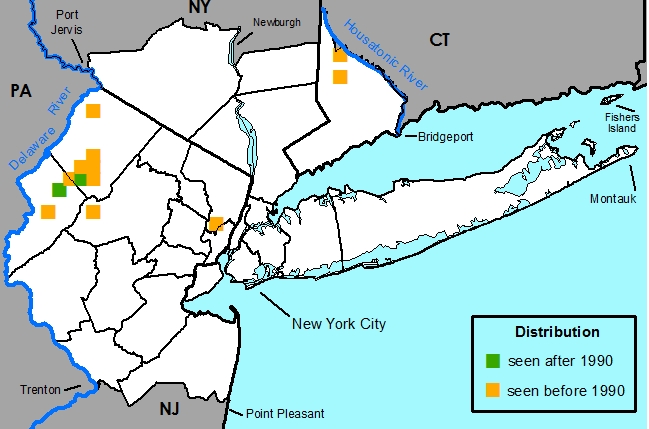Rhamnus alnifolia L'Her. - Alder-leaf Buckthorn
Common Names
Alder-leaf BuckthornField Identification
Small deciduous shrub with alternate, finely-toothed leaves; with small yellow-green flowers followed by black berries.Poisonous properties
Disclaimer: The information provided here is for reference and historical use. If you believe you have been poisoned, please contact the Poison Control Office near you (look for the number in the front of the phone book).
Ingestion of fruits or leaves can cause mild to moderate nausea, vomiting, and diarrhea; death is unlikely.
Nomenclature
Rhamnus alnifolia L'Her., Sert. Angl. 3. 1788, "alnifolius".Frangula americana Mill., Gard. Dict. ed. 8, F. no. 4. 1768.
Rhamnus franguloides Michx., Fl. Bor.-Am. 1: 153. 1803.
Rhamnus alnifolia var. franguloides DC., Prodr. 2: 25. 1825.
Girtanneria alnifolia Raf., Sylva Tellur. 28. 1838.
Girtanneria franguloides Raf., Sylva Tellur. 28. 1838.
Apetlorhamnus alnifolia Nieuwl., Amer. Midl. Naturalist 4: 90. 1915.
Apetlothamnus alnifolia Lunell, Amer. Midl. Naturalist 4: 474. 1916.
TYPE: Lectotype: PH LC-91 selected by (Reveal, Moulton & Schuyler, 1999)
Description
HABIT Perennial, deciduous, phanerophytic, shrub, diclinous and dioecious, 1-1.5 m tall.STEMS Main stems ascending or erect, round. Bark smooth, not exfoliating, dark brown. Branches erect or ascending. Twigs red or dark brown or green or gray, terete, 1.5-4 mm in diam., smooth, glabrous (occasionally finely hairy?). Pith small, white, round, continuous, nodal diaphram absent. Sap translucent.
BUDSTerminal and axillary present, scattered along stem; terminal bud ovoid, blunt; axillary buds 1 per axil, ovoid, blunt. Bud scales dark brown, imbricate, glabrous, minutely ciliate on margins. Bud scale scars not encircling the stem. Leaf scars half-elliptical, slightly elevated. Vascular bundle scars 3.
LEAVESAlternate, simple, 1 per node, spaced somewhat evenly along stem, divergent from stem. Stipules absent. Leaves petiolate, petiole furrowed, 0.5-1.5 cm long, glabrous. Leaf blades: abaxial surface light yellowish green, adaxial surface dark yellowish green, elliptic or ovate, bilaterally symmetric, 2-11 cm long, 1-5.5 cm wide, membranaceous, base cuneate or obtuse, margin serrate or crenate with minute dark glands at teeth apex, apex acuminate or acute or obtuse. Abaxial and adaxial surfaces glabrous; veination arcuate.
INFLORESCENCES Coetaneous, formed on last season's growth, unisexual by abortion, axillary fascicles of usually 1-3 flowers. Peduncle 0.3-0.6 cm long, glabrous; bractless.
FEMALE FLOWERS5-merous, 1-3 flowers per inflorescence, fragrance absent, perianth of one whorl. Calyx actinomorphic, of fused sepals, deciduous, abaxial and adaxial surfaces light yellowish green. Sepal lobes 5, triangular, 1-1.5 mm long, 1 mm wide, margin entire, apex acute, glabrous. Corolla absent. Gynoecium syncarpous. Locules 3. Styles 1, 3-forked. Ovary superior, glabrous, nectiferous disk present. Placentation basal. Androecium wanting or rudimentary and sterile.
MALE FLOWERS5-merous, fragrance absent. Perianth of one whorl. Calyx actinomorphic, of fused sepals, deciduous, abaxial and adaxial surfaces light yellowish green. Sepals lobes 5, triangular, 1-1.5 mm long, 1 mm wide, margin entire, apex acute, glabrous. Corolla absent. Stamens 5. Anthers glabrous. Filaments free, straight, glabrous. Gynoecium vestigial.
FRUITS Drupe, black, globose, 6-8 mm in diameter, glabrous; usually containing 3 pyrenes.
SEEDSSeeds brown, ovoid-triangular in outline, lenticular in cross-section, 5.5-6 mm long, 3.5-4 mm wide, glabrous, tuberculate, 1 side with 1 ridge; other side with 2 grooves.
Habitat
Swamps and bogs, usually in calcareous waters.Distribution
Indigenous to North America.
United States -- CA, CT, IA, ID, IL, IN, KY, MA, MD?, ME, MI, MN, MS, MT, ND, NH, NJ, NY, OH, OR, PA, SD, TN, UT, VA, VT, WA, WV, WI, WY
Canada -- AB, BC, MB, NB, NF, NS, ON, PE, QC, SK
New York Metropolitan Region -- Native, currently restricted to swamps of northwestern New Jersey; possibly still extant in northern Fairfield County, Connecticut.
Rarity Status
Heritage global rank -- G5Connecticut -- Not listed
New Jersey -- S3S4
New York -- Not listed
Species Biology
Flowering- May
- Pollination
- (Robertson, 1896)
Probably Myophily, Melittophily, and possibly Cantharophily.
Probably pollinated by various species in Hymenoptera (Apidae, Andrenidae, Eumenidae?, Tenthredinidae?) and Diptera ( Empidae, Syrphididae, Tachinidae, Sarcophagidae, Muscidae, Cordyluridae, Anthomyidae) and perhaps Coleoptera - Fruiting
- June-July
- Dispersal
-
Endozoochory --
Probably dispersed by avian frugivores.
Mammals: Euarctos americanus (Black Bear) (Martin, 1951)
- Germination
- (Schopmeyer, 1974)
Natural germination usually occurs in the spring following seed dispersal. Germination is epigeous. This species has embryo dormancy which can be overcome somewhat by stratification in moist sand at 41 degrees F for 60 days. Seed stored dry in sealed containers at 41 degrees F retained most of it's of viability after two years.
